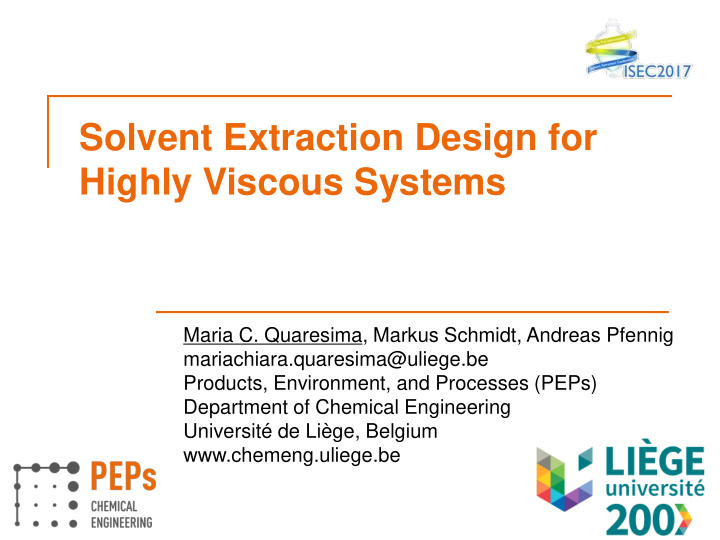



Solvent Extraction Design for Highly Viscous Systems Maria C. Quaresima, Markus Schmidt, Andreas Pfennig mariachiara.quaresima@uliege.be Products, Environment, and Processes (PEPs) Department of Chemical Engineering Université de Liège, Belgium www.chemeng.uliege.be 1
agenda motivation extraction column design single-drop behavior sedimentation mass transfer conclusions and perspectives 2
motivation sources: fossil-based bio-based higher oxygen content lower vapor pressure higher viscosity pilot-plant based design is time consuming, expensive design based on lab-scale experiments and simulations 3
the ReDrop concept 4
ReDrop simulation 5
single-drop sedimentation DN 200 100 100 camera 100 2800 1350 100 100 rising droplet 50 50 50 50 nozzle for producing droplets 6
sedimentation EFCE system 140 120 terminal velocity in mm/s 100 ideally mobile interface 80 rigid interface 60 40 T = 20 °C, n-butylacetate (d) + water (c) without mass transfer, Hoting (1996) 20 our experiments 0 0 1 2 3 4 5 6 7 drop diameter in mm M. Henschke, A.Pfennig, AIChE J ., 45, 10 (1999). 7
single-drop sedimentation 140 oscillating drop deformed drop rigid drop circulating terminal velocity in mm/s 120 drop 100 a 16 a 15 80 60 40 d SW 20 α SW 0 0 1 2 3 4 5 6 7 drop diameter in mm M. Henschke, A.Pfennig, AIChE J ., 45, 10 (1999). 8
single-drop sedimentation 4 adjustable parameters: d SW a 15 a 16 α SW system α SW Henschke d: n-butyl acetate 10 c: water d: isododecane + D2EHPA Kalem et al. 2 c: water + Zn + H2SO4 Adinata d: toluene + paraffin 5 c: water + PEG 9
increasing viscosity of EFCE system continuous phase dispersed phase water n-butyl acetate + polyethylene glycol + paraffin oil (PEG) acetone 10
sedimentation velocity d: n-butyl acetate, sedimentation velocity in mm/s 90 viscosity 0.797 mPas c: water + PEG, 75 viscosity 7.928 mPas Henschke model T=20 ° C 60 45 α SW d SW 30 low viscous 10 2.39 system 15 this system 5.44 4.28 0 0 2 4 6 drop diameter in mm 11
single-drop mass transfer 12
ATPS mass transfer 1 exp calc diameter 1.24 mm 1.42 mm 1.56 mm + concentration difference y dimensionless driving 0.9 c: phosphate buffer, viscosity 2.145 mPas d: PEG, viscosity 9.250 mPas mass-transfer component: protein albumin 0 10 20 30 40 50 60 70 residence time in s F. Buchbender, M. Schmidt, T. Steinmetz, A. Pfennig, 13 Chem. Ing. Tech ., 84, (4) 540-546 (2012)
conclusions and perspectives viscosity influence on mass transfer fitting of models parameter further investigation of viscosity dependency implementing adapted models in simulation 14
Solvent Extraction Design for Highly Viscous Systems Maria C. Quaresima, Markus Schmidt, Andreas Pfennig mariachiara.quaresima@uliege.be Products, Environment, and Processes (PEPs) Department of Chemical Engineering Université de Liège, Belgium www.chemeng.uliege.be 15
Recommend
More recommend